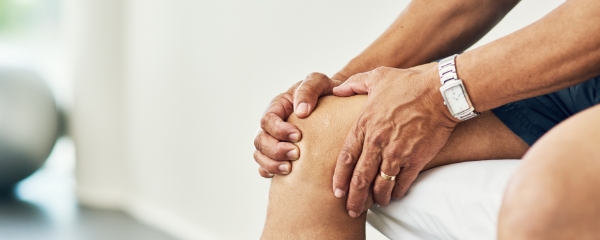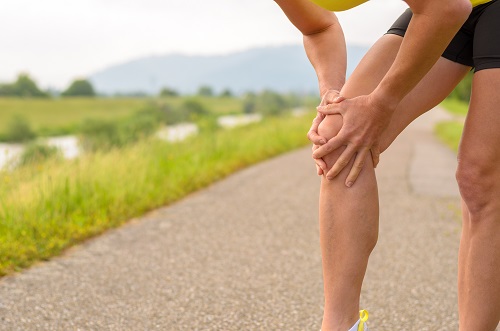
Take Action and Overcome Knee Pain

Sound familiar? Knee pain can strike as a sharp warning jab or as a slow chronic ache that makes it so much easier not to get off the sofa. If knee pain is forcing you to choose between enjoying an active life or doing only what your body can tolerate, there’s something you should know.
If you experience knee pain, you aren’t alone. Fifty million people in the U.S. alone suffer with knee pain, from disease or overuse. The culprit is, to a large extent, decades of enormous pressure exerted on these joints. Despite how remarkable the body is, it would seem like a design flaw to put so much pressure on a joint with only a half-inch shock absorber.
Even when walking on level ground, you exert a force of 1 1/2 times your body weight on your knees. Walking up or down stairs can increase to a force 2-3 times your body weight and when landing from a jump, your knees can absorb 6-8 times your body weight. With these kinds of multipliers, carrying just a few extra pounds of weight over time can have a big impact on your knees.
Basic Anatomy of the Knee
The vast majority of knee pain stems from compromised ligaments or cartilage. Note the anterior and posterior cruciate ligaments, the ACL and PCL, in the middle of the knee joint. These ligaments have the crucial role of connecting the thigh and shin bones and patella (knee cap).
Cartilage is the shock absorber that protects the ends of the bone from rubbing against each other. We have what is called articular cartilage that adheres to the ends (condyles) of the femur and tibia, and a meniscus, which is a cushion of tougher fibrocartilage that rests atop the tibia.
When an injury or condition causes your joint to become inflamed and swollen, or tears and wears the cartilage down, nerves become entrapped or pinched, causing your brain to register the “warning siren” of pain.
Knee Pain and Your Body
Knees are the most common site of pain in adults over 50. This pain prevents millions of Americans from doing the things they enjoy and, in fact, the very things that benefit the musculoskeletal system overall.
Knee pain can have a domino effect on other body systems as well as the muscoloskeletal system. When you favor one knee over the other because of pain, the reduced activity can affect your digestion and hormones, even your emotional wellbeing. Worst of all, your cardiovascular health can suffer from leading a sedentary life, as excess weight accumulates, blood pressure rises, blood vessels lose elasticity and the heart muscle itself weakens.
Common Causes of Knee Pain
Arthritis
The most common cause of joint pain is arthritis – an inflammation of the joints where bones meet.
Although there are more than 200 different types of arthritis, all involve damage to cartilage. Cartilage acts like a cushion for the bones and it covers the ends of bones where they meet to form a joint. When the knee cartilage is damaged, bones rub together when an individual moves and this friction causes knee pain.
Three basic types of arthritis may affect the knee joint:
1. Osteoarthritis
The most common form of arthritis is osteoarthritis, often called “wear-and-tear” arthritis because it occurs when the protective cartilage on the ends of the bones wears down over time. Osteoarthritis affects millions of people around the world and symptoms can develop slowly and worsen over time.
OA is usually slowly progressive. It most often found middle-aged and older people.
Factors leading to OA include:
- Heredity; OA runs in families
- Being overweight
- Fractures or other joint injuries
- Jobs that involve kneeling or squatting, as well as jobs that involve lifting, climbing stairs or walking
- Playing sports that involve direct impact on the knee joint
2. Rheumatoid Arthritis
Another major type of arthritis is rheumatoid arthritis, an inflammatory type of arthritis that occurs when the body’s immune system does not work properly. Gout is another common type of arthritis and it occurs when there is an excess of uric acid in the tissues and blood. RA can occur at any age. RA generally affects both knees.
3. Post-traumatic arthritis
Post-traumatic arthritis can develop after an injury to the knee. This type of arthritis is similar to osteoarthritis and may develop years after a fracture, ligament injury or meniscus tear.
- Pinching of the inner lining of the knee during movement (plica syndrome)
- Gout
- Infections caused by a virus
- Injury, such as a fracture
- Osteomyelitis (bone infection)
- Septic arthritis (joint infection)
- Tendinitis
Other Causes of Knee Pain
- Gout: Pain and swelling in (usually) one joint. Caused when the kidneys do not properly filter the uric acid out of the bloodstream, resulting in an accumulation in the joint.
- Bursitis: Pain and swelling in one or more joints. Caused by inflammation of the bursa, sacs filled with fluids that lubricate the joint.
- Torn ligament (ACL or PCL): Pain and swelling of a knee joint. Caused by a partial or complete tear of one of the two ligaments that attach the tibia (shinbone) and femur (thighbone).
- Torn Meniscus: Pain and swelling of a knee joint. Caused by a tear in the cartilage pad resting on top of the tibia.
- Osteonecrosis: Reduced blood flow to bones in the joints.
- Synovitis: Inflammation of the joint lining. This is most commonly caused by overuse.
- Sprain: Pain and swelling of the joint. Caused by an injury that creates micro-tears in the ligaments or tendons supporting the knee joint, which normally heal with time and rest.
- Overuse of Joints: When a joint is “overused” this means that repetitive activity has been done over a long period of time, leading to inflammation and pain in a joint. Athletes may be particularly prone to such pain. Symptoms may disappear for a short time with rest, but they are likely to return.
Long-term joint pain, no matter the cause, ranges from mildly irritating to a chronic, debilitating condition. There are many proven treatment options that can reduce pain and inflammation and preserve joint function.
Knee Pain Treatments
Our orthopedists see patients with everything from minor knee pain that can be treated with rest and self-care to patients with chronic, serious knee pain that requires a non-surgical or surgical treatment plan. Learn more about knee pain treatment options and when you should seek treatment.
Lifestyle Treatments
Memorial Hermann Joint Centers can offer help on making lifestyle changes that include minimizing any activity that puts stress on your knee, losing weight for less pressure on your knee and switching from high-impact exercises like running to low-impact exercises.
Nonsurgical and Minimally Invasive Treatments
When joints are damaged, either due to arthritis or other diseases or injuries, and the patient has pain, stiffness or swelling, there are many treatment options to explore with help from Memorial Hermann.
Knee Replacement Surgery
Arthritis or traumatic injury to the knee can cause pain, deformity and stiffness that can severely limit daily activities. Knee replacement can alleviate that pain and restore the normal alignment of the knee, allowing you to move easily.
Find Relief from Joint Pain
Each year, Memorial Hermann Joint Center physicians perform more than 3,000 hip and knee joint replacement procedures, more than are performed at any other hospital system in the Greater Houston area.
If you're experiencing symptoms of knee pain and are seeking relief, Memorial Hermann Joint Centers can help. Our orthopedists see patients with everything from minor knee pain that requires rest and self-care, to those with chronic, serious knee pain, requiring a targeting non-surgical or surgical treatment plan. Find a location near you.
Let's get started.
Contact us to learn more about Memorial Hermann Joint Centers and pain-relief solutions. Submit the form below and the Memorial Hermann Joint Center navigator will reach out to answer your questions and help guide you down the path to a life with less pain.